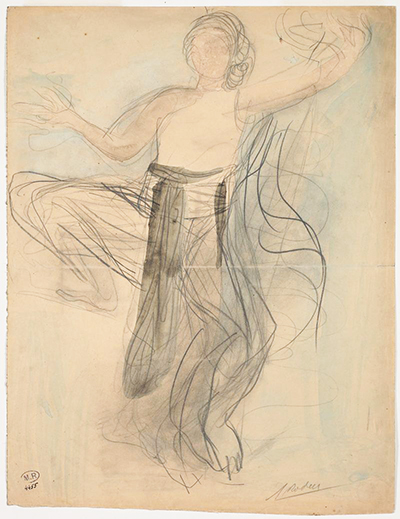Rodin's Cambodian Dancer drawings showcased the dancer's elegant movements, graceful hands and flowing tonics with great skill. The troupe had accompanied King Sisowath of Cambodia during his official visit to France in 1906.
Charmed by the novelty of the dancer's movements, Rodin decided to follow them to Marseilles where he sketched 150 drawings before leaving the country. When drawing the Cambodian Dancer Front View, Rodin illustrates the dancer's extraordinary beauty and monotonous dance as she flows with the pulsating rhythm of the music. He, however, eliminates the dancer's face, garments and hairstyle to demonstrate the dancer's concentrated energy and age-old gestures. Auguste also uses gouache painting method exhibited by the broad brush strokes used to contour the lines and emphasis on the dancer’s crouching pose.
Rodin created these the Cambodian Dancer sculptures at a time when he had shifted his focus to Mouvements de Danse style. He no longer sketched rigid forms but emphasised on human flexibility. It explains why the resulting sculptures showed each dancer's extremity with graceful dance postures. Cambodian Front View articulates the revelation that dances liberated the artiste's bodies from the constraints the traditional ballet dance and allowed them to discover the possibilities of body and spirit. Rodin would start by sketching the drawings in delicate pencils and ink to capture the fluid gestures in the dancer's movements. He explained that body movements could be embellished in geometric patterns using few, simple lines. Rodin then proceeded to create different carving on the sketched dancers hence, the famous Cambodian Dancers sculptor. When viewed separately, the bits of limbs appeared as a collection of small plaster figures, but when put together, they demonstrated invigorating humanity about them.
Rodin's focus on these sculptures laid the foundation for the Mouvements period in France. His interest in sketching dancing silhouettes was not new. He had embarked on this style in the 1890s along with Stephane Mallarme and a few colleagues. Pictures in Rodin's avant-garde archive like Isadora Duncan and Ruth St Denis, Loie Fuller and the acrobatic Alda Moreno dancer illustrate his fascination with dance movements. This interest opened new possibilities for Rodin's sculpting work. It extended beyond mere movement and became a fascination with the dancer's body. Some drawings exhibited a passionate, erotic urgency often displaying the genitalia of nude performers.




